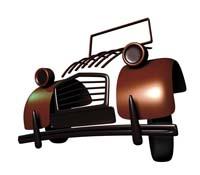Life, a car for farmers

The first model of Citröen 2CV had 8 horsepower. A misunderstanding, however, rooted in popular tradition the belief of having 2 horsepower, which gave the car the name that people on the street used for a long time. In French, deux chevaux ; in Spanish, two horses ; and in Basque, they call it life.
But the name 2CV did not indicate power, but had a two-cylinder V-shaped engine. Total 375 cc. It is a small engine from today's standards, but if we look back at that time, Citröen invented everything. This engine had a very low consumption and was a good car for citizens.
At the time when life was designed, in the 1930s, France was mostly a rural village. For this reason, the director general of the company Pierre Boulanger Citröen asked the engineers to design a car for them. The order was very clear, only the car had to have essential elements to function. "Four wheels under an umbrella," he said. In addition, it had to meet simple conditions: on the one hand, there had to be a space for two champions; on the other, it had to bear a load of 50 kilos and, in addition, it had to transport a box filled with egg in a growing area without breaking the eggs. The first prototype created in 1936, model of 8 powers on horseback, met all these requirements. The egg transport test is also filmed.
And it wasn't just that. It had to be necessarily a cheap car so that farmers could buy it. For this purpose, the design resorted to the minimums. For example, it had the only previous light, since in France they did not ask by law to have two lights. And it had aluminum body, a very cheap metal. The problem was that aluminum is not a very resistant material, so Citröen contracted the front plate and increased the hardness without the car being very expensive.
Second World War
That of Bizaldi was not sold at that time, but was wanted to present at the Paris car fair in 1939. But that year, while Citröen manufactured the prototypes, Hitler entered Poland. On 3 September, France and England declared war on Germany and the French left the fair.
Those of life, a work of engineering so appropriate for the work of the peasants, feared to end up in the hands of the Germans. By then it had already manufactured 250 units and Boulanger decided to destroy them all, except one (four units according to sources). The car is dismantled and the pieces are hidden in a farm until the end of the war.
After the war and until France recovered normality, several years passed. Citröen again completed his life and made him some adaptations. For example, the engine was subjected to a water-free cooling system. An engine that does not need water cannot have breakdowns due to lack of water. On the other hand, the aluminum plate was replaced by steel.
Citröen presented his new car at the Paris fair of 1948. And according to the chronicles, the simple vision of life provoked laughter to many critics. An American journalist, for example, asked if there was an abrelate included in the price.
However, the success of engineering is not in the hands of critics. The postwar model was a 9 horsepower car, with a consumption of less than five liters in 100 kilometers, a speed of 65 kilometers per hour and a surprising suspension system, capable of not flying the car. In addition, it was three times cheaper than the American standard car. It was a car designed for the village and the village responded. The sales were spectacular. In 1950 there was a six-year waiting list to buy a life.
History of technological evolution
Over time, new models were created that adapted to the current situation and technology of each moment or created new vehicles, such as vans. As a result of this development emerged the evolved of life and, from a moment, the vehicles beyond life. Finally, that of life was the evolutionary predecessor of many cars: Van H (1951), Sahara (1958, a 4x4 car), Ami 6 (1961), Diane 6 (1967) and Mehari (1969).
Comparable to the evolution of living species, the original starting point of Citröen's "genealogical zuhatitz" would be that of life. But there is a great difference: the proper of life lasted longer than all its descendants, both in production and in the market. The following were cars of great success, but disappeared very quickly with respect to the original.
Over time, Citröen stopped manufacturing that of life. The last one was manufactured in 1990. It sold a total of 3,800,000 copies. Undoubtedly, the car of the peasants was key in European machining. It was not the only one, the philosophy and the result was the same in Volkswagen Sedan, the beetle, the creation of the car. Hitler himself asked to design a car for the village (Volkswagen means town car) and, during the war, used the beetle as a military car. Subsequently, he helped Europe modernize, along with that of life.
Buletina
Bidali zure helbide elektronikoa eta jaso asteroko buletina zure sarrera-ontzian











